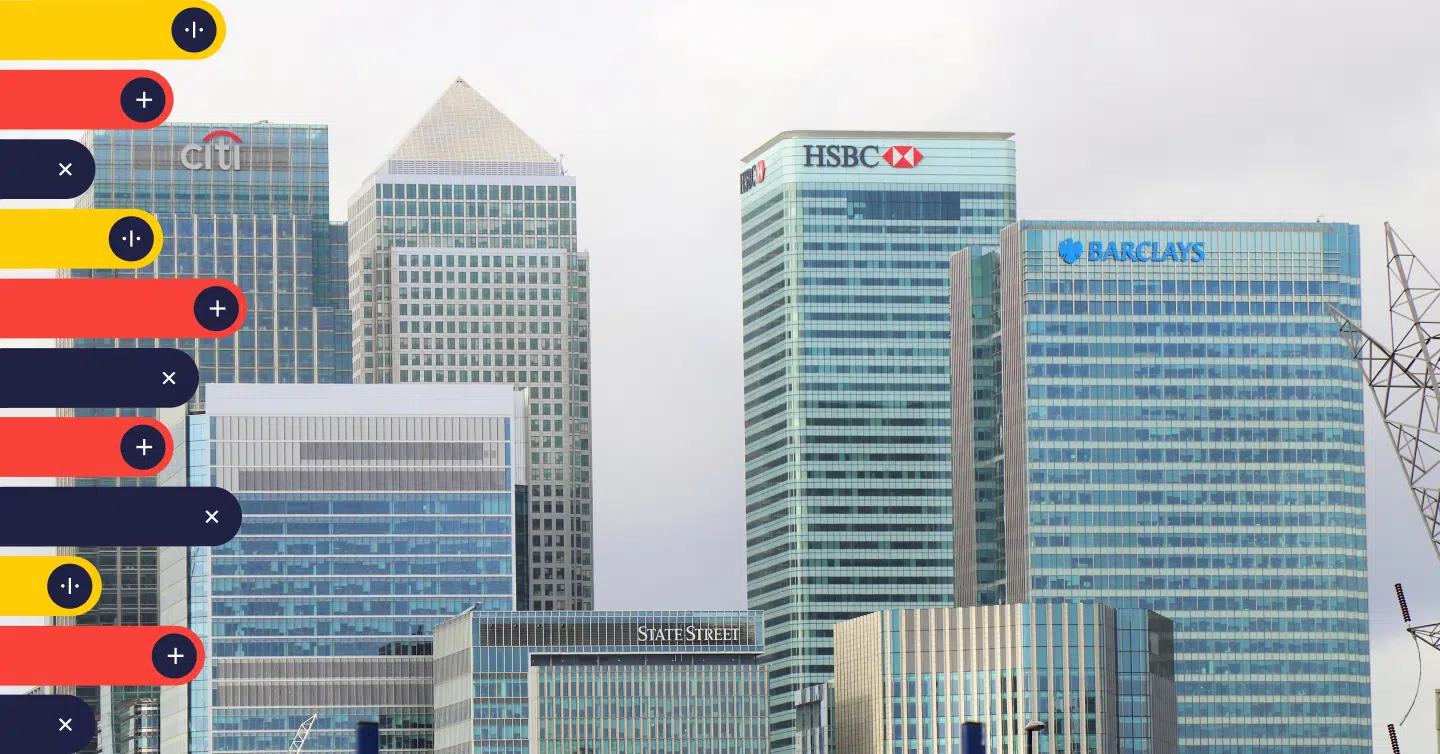Impact of Bank Failures on Canadian Mortgages

Table of contents
Last weekend was one of the biggest tests of the central bank’s inflationary measures on the US banking system. Two regionally large US banks, Silicon Valley Bank (SVB) and Signature Bank of New York (SBNY), failed due to a bank run. These banks are large by any comparison – together, their assets would add up to a bit larger than Canada’s 6th-largest or North America’s 12th-largest financial institution, National Bank.
Since then, a few other banks, including First Republic and Charles Schwab, have experienced an implosion in their share price and depositor trust – but none has been as concerning as Credit Suisse. Credit Suisse, TD, and RBC are part of a list (Global Systemically Important Banks) of 30 banks worldwide that legislators have deemed too important to fail. Basel rules hatched out after the 2008 liquidity fiasco required these banks to maintain a certain level of liquid capital to reduce risk to the global economy.
Some experts say that the recent bank failures south of the border could be enough to drive the Bank of Canada (BoC) off its path of inflation-targeting rate hikes. In this blog post, we look at what impact these bank failures have on financial stability and Canada – more to what’s lingering on everyone’s mind – how this will affect mortgage rates in Canada.
Key Highlights
- Silicon Valley Bank’s failed due to its lack of diversification and rapid growth.
- FDIC created market stability and saved the tech industry by covering insured and uninsured deposits of failed banks.
- The stability in the bond market has caused an increase in bond prices. Bond prices are inversely correlated to bond yields.
- Lower bond yield can usher in lower mortgage rates and increase housing affordability for potential homebuyers.
Why Did Silicon Valley Bank Fail
Silicon Valley Bank was thriving – due to the surge in venture capital, it was the biggest and main financier of the tech sector. Credit losses were quite low, and deposits tripled between 2019 and 2021. This sounds great, right?
When banks accept deposits, they owe that money back to the client. So deposits are considered liabilities for the bank – additionally, so is the interest owed on these deposits. Banks lend these deposits as small business loans and mortgages to turn these liabilities into assets.
If a bank can’t lend responsibly, it often buys loans or “securities” like US Treasuries or Mortgage-Backed Securities (MBS), which have minimal risk as they are government-backed. Much of the money SVB received was from venture capital funds which needed to place their cash somewhere – these were not small deposits.
The deposits were pouring in during the 2019 to 2022 surge while rates were low. SVB bought a lot of US government treasury bills – on very long 10+ year maturities. They did this as the longer maturities could give them better rates than the shorter maturities, as the interest rates were so low during this period.
When rates rise, fixed-income prices fall. The rule of thumb is that every 1% increase to the rate means a loss of 1% per year that you need to hold that bond. For simplicity, for each 1% increase, the value of the bonds they held depreciated by 10% (for the 10 years they must hold that bond).
So SVB bought high-qualify assets but bought tonnes of them when rates were low with long durations. This is a big liability. But only if all the depositors ask for their money to be returned at the same time.
Technically, if the depositors ask for their money simultaneously, SVB will have to sell these bonds at market value, thus crystalizing its temporary losses. If these losses are big enough, it will need more money to pay out all the depositors. But once it starts – no one wants to be the last depositor left standing. Thanks to social media, which as a side note, did not exist in the same capacity in 2008, once a whiff of the issue pops up – large depositors start to run.
The FDIC does not insure large depositors – those depositors have the incentive to find highly sound banks. SVB had large deposits, which easily created a bank run. As deposits go in reverse, it had to sell its assets to payout its depositors.
The financial regulators – FDIC and Federal Reserve, step in to turn its less liquid assets into more liquid and cover everyone’s deposits as promised. Even the uninsured ones that they didn’t have to – in the hope that it creates market stability instead of a cascade of bank runs.
Additionally, it has come to light that the chief risk officer at SVB had stopped performing her role by October 2021 and was packed out with $2.5 million in April 2022. So for over 8 months, they did not have a risk officer. So far, what prompted her to leave is unknown – was it the inability or interference to perform her duties or the forced exit with a big payout to keep quiet?
Find a better rate, and we’ll match it, beat it, or give you $500*.
*Conditions Apply
With nesto, it’s stress-free
With Great Profit Comes Great Responsibility
Back in 2008, when the US had another banking crisis well entrenched in most people’s memory, it was Bear Stearns. This highly regarded 85-year-old Wall Street investment bank severely stressed financial markets with its failure. It narrowly avoided bankruptcy with its sale to JP Morgan Chase at a low price of $2 per share, which is quite a decline from Bear Stearns’ market capitalization of $20 billion a year prior.
The markets didn’t recover from the severe stress of the subprime mortgage loss at that time, and 6 months later, Lehman Brothers, along with Merrill Lynch, AIG and Washington Mutual, met similar fates, which set off the worst international banking crisis and drove the US into the biggest financial meltdowns since the Great Depression.
The US government stepped in with assistance from big banks such as JP Morgan Chase (bought Washington Mutual and Bank of America (bought Merrill Lynch), which bought out the failing investment banks.
AIG was massive and needed quite a bit of assistance from the US federal government, which became a big shareholder until the company could be split up and bought out by various insurers.
Even though these large bailouts meant that US taxpayers were left on the hook to pay for the risks these investment banks took, they served a vital public good by providing stability to the market. Once again, the Federal Reserve has done the same – by providing the liquidity needed to cover SVB’s deposits and protect the tech industry in North America.
There are big differences between what happened in 2008 and this last week. In 2008, there was a bit of a credit crisis where banks’ assets were so interwoven that it was hard to tell who owned what. The undesirable and risky US mortgage debts were repackaged as investments making it harder to assess their losses.
This time around, it’s a very different picture. The underlying assets at the centre of the bank failures, US Treasury Bonds, are some of the most liquid and transparent making it easier to assess the losses.
Bigger US banks are also unaffected by this banking crisis, thanks partly to the US Dodd-Frank Act and the international Basel reforms adopted after the 2008 crisis. These reforms require big banks deemed too large to fail must have a larger cash capitalization.
Additionally, in 2008 social media did not exist as it does today, making it harder with all the digital fear-mongering that escalated this past week in the US, causing bank runs there. Regulators in Canada and the US have been preparing for such a scenario by creating more awareness and education around FDIC and CDIC.
Silicon Valley Bank may not have been on the too-big-to-fail list, but it was still a big bank in terms of its assets.
To help you understand what this means comparatively with banks that have their relationship north of the border, we have compiled a list of the largest Canadian banks and how they compare with the US banks.
| Bank Name | Ranking in North America | Assets ($CAD in Billions) |
|---|---|---|
| RBC | 4 | $1,990 |
| TD | 5 | $1,928 |
| Scotiabank | 6 | $1,374 |
| BMO | 7 | $1,146 |
| CIBC | 8 | $921 |
| BNC | 12 | $418 |
| Desjardins | 14 | $408 |
| Silicon Valley Bank | 16 | $289 |
| Signature | 29 | 152 |
Fight Inflation or Create Stability
As the FDIC took SVB and Signature Bank into receivership and provided liquidity to its depositors, it stabilized the market. The government agencies swiftly prevented contagion from spreading to the rest of the market. It’s done the same with Signature Bank – just as Switzerland’s central bank has thrown a lifeline to Credit Suisse to avoid a similar story being told in Europe and elsewhere.
The FDIC has also provided a lifeline to the tech industry by protecting the trust from the underlying venture capital which held deposits at Silicon Valley Bank. Unlike their US counterparts, Canadian banks are much more diversified (capital markets, wealth management and diverse lending across industries and regions). They also have higher capital requirements than the failed regional US banks.
The SVB Canada branch did not need CDIC protection as no deposits were being held there. The Canadian regulator has stepped in with plans to sell off the business. The confidence crisis did chip away at the share prices of large Canadian banks, with over $20 billion of their market share being eaten away in a day’s total on Monday. TD was affected the heaviest – likely due to their heavy involvement in the US markets, as almost 4% of its market share disappeared overnight.
Banks will have to raise deposit rates, which will hurt the sector’s revenue prospects and will certainly tighten regulatory requirements. But SVB’s failure suggests that this is exactly what is happening after years of quantitative easing, zero interest rates and central bank repression.
Bond Prices Up Means Rates Are Heading Down
Market declines this past week have raised the prospect of recession. Bond traders are pricing in the instability and handling it by federal agencies by increasing their uptake. This bigger move to buy bonds has increased their pricing, thus reducing the yield on them. Bond yields and interest rates have an inverse relationship.
Investors reduced their bets on further rate hikes from the US Federal Reserve and Bank of Canada as the Silicon Valley bank’s bankruptcy exacerbated tensions between fighting inflation and managing financial stability risks.
Until last week, markets were expecting the US central bank to raise rates by 100 bps (a basis point is 1/100th of a percentage point) over the next few months and delay rate cuts until 2024. At a congressional hearing last week, Jerome Powell told legislators that he expects to raise rates several more times.
The Fed is set to raise rates again on March 24th; however, a 50bps hike is not expected and will quickly fade into the background. In contrast, the Bank of Canada will not need to change its tune as it paused its monetary tightening campaign the previous week but left room for further rate hikes. Interest rate swaps that factor in market expectations for upcoming central bank decisions now consider the end of further rate hikes and cuts by the Bank of Canada this summer.
Expect Mortgage Rates to Head Down and Home Prices to Head Up
Over the course of a week, US 5-year bond yields have dropped by 100 bps, and Canadian counterparts followed with a similar 46bps decline. This spells good news for homebuyers and mortgage renewers alike, as the Government of Canada’s 5-year bond pricing is generally a precursor of fixed mortgage rates.
Increases in bond pricing will put additional downward pressure on fixed mortgage rates and could spell a lower-bound limit for the BoC’s Overnight Policy Rate. This could mean better variable rates are just around the corner as investors price in lower rates as soon as this summer instead of the originally expected after the mid-year mark in 2024.
With mortgage rates likely to reduce over the coming months, the timing couldn’t be better as spring lending seasons roll out in Canada. Canadians caught between lower house prices, and higher stress test rates could soon sigh relief as rates come down. Once qualifying and interest-carrying costs start their downward trend, homebuyers sitting on the sidelines could quickly drive up prices as the housing supply remains strained in this country.
Buyers must know that a rate reduction does not mean inflation is curbed since North America never fulfilled the central banks’ desire for a recession. This could mean that once home prices start their climb, they could increase quite quickly. Additionally, if inflation runs away, the Bank of Canada could again continue its inflationary fight and start rate hikes to stop a double recession, as seen in the 1970s.
Runaway inflation could present a crucial risk for Canadian home prices and affordability if swift action is not taken to bring meaningful changes to the housing supply. Without increasing accessible housing for Canadians, inflation could quickly become uncontrollable and scare potential buyers from investing their money in the market.
Now is the time for policymakers to consider proactive measures to boost construction and provide economic security. Whether through government or private investments, it’s important to remember that inflation should be seen as a catalyst for opportunity, encouraging stakeholders in Canada’s housing sector to continue pushing forward with home building.
Expectations for Canadian Homebuyers and Homeowners
As expectations increase for rates to reverse their course and head downward, homeowners and homebuyers should expect home prices to increase. If you’re one of many Canadians waiting for the right time to get off the sidelines; or a homeowner looking to renew their mortgage – timing will be of the utmost importance.
The window may be small for homebuyers to benefit from reduced property values. Your qualifying mortgage amount will increase only once the stress testing criteria, and mortgage rates drop. Your limiting factors on one side are reduced rates and, on the other side, increased property values.
For homeowners, if you’re looking to renew your mortgage, you may still benefit from more patience. Either ride out time by renewing to a shorter term fixed rate while you wait for bigger drops in rates in the longer term fixed pricing. Or you can wait for the Bank of Canada to reverse course on its Policy Rate before bigger drops are seen in fixed rates.
Homeowners looking to refinance their mortgage should practice patience. The longer you wait, the further rates are expected to fall, and the more your equity will build as your property value increases over the same time. The biggest limiting factor for everyone is a possible resurgence in inflation – which could hammer property values and cause a possible reversal by central banks.
FAQ
Our FAQ section is designed to help you make informed mortgage decisions whenever you need a new mortgage or to renew/refinance an existing one.
Why did Silicon Valley Bank Fail?
Silicon Valley Bank failed due to a lack of diversification for its business lines. Instead of using depositors’ money and lending it out to borrowing clients, they bought long-term US treasury bonds in a market with very low-interest rates. As clients asked for their deposits back, they did not have the liquidity (cash on hand) to pay back their clients and realized a loss on these bonds as they had to sell them at a discount.
How is Silicon Valley Bank’s failure different from the 2008 recession?
In 2008, the underlying securities were riskier based on bad mortgage debts. In the case of SVB, the securities are high qualify US government bonds which are very liquid. The bank failed as they had to liquidate the US bonds at a discount since they had long maturity (10+ years), but the bonds were bought throughout the last couple of years when the rates were quite low.
Why is the bank failure good news for Canadians looking to buy real estate or renew their mortgage?
The bank failures created a surge in the price of bonds due to the Fed stabilizing the market by creating liquidity for SVB. Bond prices are inversely correlated with bond yields. Bond yields have dropped significantly on both sides of the border, making expectations of a turnaround for mortgage rates likely. As mortgage rates fall, property values are expected to rise.
When mortgage rates fall, it will make it easier for borrowers to qualify (stress test) for a bigger mortgage. As property values increase, it will make it less risky for lenders to take on new borrowers with renewals or purchases.
Final Thoughts
In conclusion, we have seen that bond yields are declining, which could cause mortgage rates to drop. Property values may follow suit with nominal increases in the short term as the mortgage rate slides downward. The implications of the US bank collapse could benefit Canadian home renewers and buyers who prepare themselves by staying informed. But while mortgage rate drops can save you money in the long term, it is prudent to be aware of a possible reversal in both due to a resurgence in inflation.
Speak with our commission-free mortgage experts today to assess your ability to qualify and ensure you get the best mortgage rates!
Ready to get started?
In just a few clicks, you can see our current rates. Then apply for your mortgage online in minutes!















